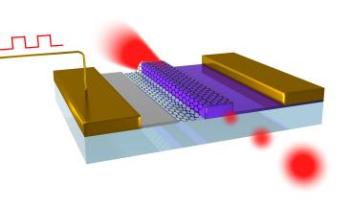A UC Berkeley team led by engineering professor Xiang Zhang, has developed a nano optical system that deploys graphene, a crystallized carbon layer with a thickness of one atom, to turn light on and off.
This feature forms the basis of a network modulator, used to monitor the speed of data packets being transmitted. The speed of the data pulses is directly proportional to the volume of data being transmitted. The modulators could be used to screen feature length, high-definition, three-dimensional films onto a smartphone within seconds.
 Bwekwlwy’s schematic illustration of the graphene-based optical modulator
Bwekwlwy’s schematic illustration of the graphene-based optical modulator
According to Zhang, director of a National Science Foundation (NSF) Nanoscale Science and Engineering Center at UC Berkeley, the technology could improve computing and communication capabilities. He also said that by using graphene, it is possible to design compact modulators that perform at considerably high speeds.
The research paper has recently appeared in the online journal, Nature. It describes how the team monitored the graphene electrically to enable it to absorb light in wavelengths suitable for data transfer. According to Ming Liu, post-doctoral student and co-author of the paper, scientists in Korea have developed 30-inch sheets of graphene in the past. But to design one billion optical modulators, the amount of graphite available in one pencil is sufficient. The electron’s energy or its Fermi level could be modified according to the voltage applied to the layer. The Fermi level can be used to determine whether or not the light has been absorbed. Electrons are emitted out of the graphene when enough negative voltage is applied, and cannot absorb photons any more. The light is turned on since the graphene turns completely transparent when the photons pass through it. Graphene is transparent at particular positive voltages since in such a case, the electrons are so tightly packed they are unable to absorb the photons.
A sweet spot was discovered in the center where just sufficient voltage was applied to enable the electrons to stop the photons from passing, turning off the light. Graphene was placed inlayers on a silicon waveguide to develop the modulators. A 1 gigahertz modulation speed was achieved, but by theory it could reach 500 gigahertz for one modulator. Light waves lose their agility when tightly packed, making photons applicable in larger solutions such as fiber optic lines.